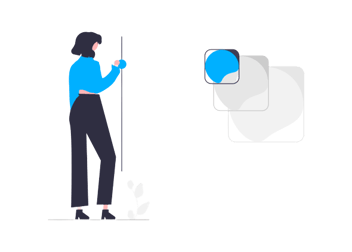What are examples of innovative customer support strategies?
Now more than ever, customer service is a more holistic role, often called Customer Support. It influences the entire buyer's lifecycle – from acquisition to retention and, if your brand fails to provide quality support, you will lose them to your more attentive competitors.
Customer support guidelines
Advanced customer support strategies can breathe new life into your company, so if you’re ready to see the growth, start with these 10 customer service strategies:
Equip your team with the appropriate tools
Giving your customer support team the resources they need is your first step to taking their performance to the next level. The right tools will help to streamline their workflows, simplify interactions, and keep them up to date with users' preferences.
Some highly effective examples include:
- Shared inboxes
- A support ticketing system
- Live chat
- Social listening tools
- Internal communication software
- Centralised reporting dashboard
For more about these and more powerful solutions, check out this blog about our top 7 essential customer service tools. With these features, your team can deliver personal, efficient, and professional service every time.
Provide self-service options
Consumers value efficiency so if you can offer an effortless service, they’re sure to appreciate it. To that end, self-service options are becoming increasingly important for companies in a range of industries.
As many as 81% of customers try to resolve problems themselves before reaching out to customer support, so by integrating a few self-service tools into your operations, you can make the whole process easier and more convenient.
Examples include:
- Frequently asked questions (FAQs)
- Helpful articles or blogs
- Downloadable guides
- Online shopping
- Self-checkout machines
If in doubt, use a survey to ask your front-line employees what they think would be most helpful based on the questions they receive most from clients, and then create the resources that help answer those questions.
Employ the right people
Before recruiting front-facing employees, you need to ensure you’re looking for the right qualities. For starters, these team members need to align with your company values, to ensure they convey them convincingly to your target audience.
At the very least, customer support staff need to have:
- Patience
- Social awareness
- Strong communication
- An openness to learning new things
- Empathy
- A base-level knowledge of the company, products, and services
Customer support is all about troubleshooting issues, resolving problems, and de-escalating tense situations. Since those things aren’t easily taught, you need to attract talented and skilled employees by offering an attractive pay rate and career advancement opportunities.
Keep your employees motivated
The mood of your staff has a direct impact on customer satisfaction, so you must take steps to enhance employee welfare. The way your staff are treated and appreciated will flow through to the way they treat clients, whether positive or negative.
To ensure your employees can give their highest standard of service, ask the following questions:
- Do staff feel empowered and supported to do their jobs?
- Does performance vary from month to month depending on morale?
- Are there any common complaints amongst employees? How can you solve them?
- What are some more rewarding employee benefits?
To answer these questions, you will need to speak with employees directly and ask for their input through surveys or interviews.
Maintain good customer communication
Communication between your employees and customers is crucial to customer satisfaction, so you need to make it a priority. Firstly, determine which communication channels are optimal for your users. Ask yourself, is email or calling the better option? Or perhaps live chat, chatbots, or on-site interviews.
Regardless of the channel, to communicate with customers, you must:
- Respond quickly.
- Speak clearly, with respect and patience.
- Apply personalisation, particularly with greetings.
- Use positive language.
- Avoid blame or excuses.
- Be accessible and transparent.
At the end of any interaction with support, a client should feel heard, valued, and confident that the company is taking relevant next steps.
Solve problems effectively
When reaching out for support, customers generally have a request or problem in need of resolution. To give high-quality service, your company’s goal should be to provide those resolutions both promptly and successfully.
Speed is important but it’s more important to actually solve the problem at hand. If you make empty promises and fail to follow through, the client will grow impatient and abandon your brand for an alternative. For that reason, be sure to use metrics that measure customer satisfaction, not just speed.
Make it easy for customers to get support
The more hassle-free a support interaction is, the happier your customers will be. They expect service to be effortless and seamless, especially when they’re already frustrated and impatient.
To provide effortless service, consider implementing:
- Live chat functions on your website and app.
- In-person assistance for those who prefer face-to-face interactions.
- A well-designed Frequently Asked Questions page.
- Clear, informative content on your website, such as blogs or tutorials.
- A responsive social media team to provide a more approachable channel.
The ideal way to achieve this is by implementing a Customer Effort Score (CES) survey which will ask users how easy it was to get the support they needed. The responses will highlight any major sticking points and show what is currently working well.
Balance automation with personalisation
While technology does provide us with a lot of beneficial tools, you need to use them with caution. Automation is an incredible addition to a support team’s toolkit, but only when it’s used to benefit the customer.
In most cases, automation and Artificial Intelligence allow support teams to be more efficient but be careful to pair them with real, personal interactions as well. For example, a chatbot can answer a lot of basic questions but for more complex situations, a human conversation will be more helpful.
Before using an automation tool, consider:
- Is this method better than the alternatives?
- Will a human be better equipped to handle this sensitive situation?
- Does this situation demand patience, compassion, and empathy?
Before you make the decision, ask customers what they would like most. If the use of a tool could result in irritation or make them feel ignored, a personal response will be far more successful.
Prioritise retention over acquisition
While acquiring new prospects is important, retaining existing clients is far more profitable. In fact, a mere 5% increase in retention is shown to raise profits by 25% to 95%.
To improve customer retention, you should:
- Listen to consumer insights and act on them.
- Develop products tailored to customer needs.
- Equip employees with the most suitable resources.
- Provide incentives for loyalty.
Customer loyalty comes down to how well you serve them so instead of focusing on new marketing prospects, focus your efforts on keeping your existing users happy.
Get feedback from your clients
Often, companies fail to understand their clientele because they don’t ask for their input. To tap into your target market's preferences, you need to implement a feedback strategy.
A good feedback strategy includes tracking and measuring responses from a variety of channels. This can include customer complaints, online reviews, surveys, live chat, polls, and social listening.
Customer feedback allows you to:
- Understand the client's wants and needs.
- Recognise issues in the buyer’s journey.
- Resolve problems quickly.
- Make informed decisions.
- Improve the User Experience quickly.
To find out more about improving your support processes, sign up to Review Tui. You’ll get valuable advice and access to customised tools so that you can easily collect and evaluate feedback from your valued customers.



